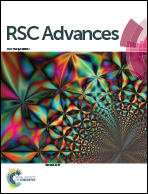Thiol–ene photoimmobilization of chymotrypsin on polysiloxane gels for enzymatic peptide synthesis†
Abstract
Chemical incorporation of enzymes onto polymeric materials has recently attracted intense scientific attention. Cross-linked polysiloxane gels as a typical super-hydrophobic support, are a good candidate for supporting enzymes in low-water organic medium to efficiently catalyze peptide synthesis because the hydrophobic polysiloxane matrix can prevent water from attacking the acyl-enzyme intermediate, which is beneficial for the shift in equilibrium to peptide formation. In this work, we develop a facile strategy to photoimmobilize olefin-functionalized chymotrypsin onto cross-linked polysiloxane gels via UV-initiated thiol–ene click chemistry. The impacts of water addition amount, heat-treatment and recyclability of the immobilized chymotrypsin influencing the peptide synthesis efficiency are investigated. Compared with the native chymotrypsin, polysiloxane-immobilized chymotrypsin showed advantageous catalytic activity, higher thermal stability and superior recyclability.



 Please wait while we load your content...
Please wait while we load your content...